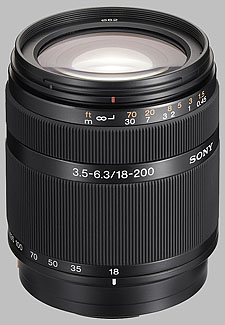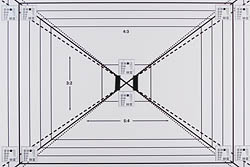| 18-200mm |
$500 average price |
|---|---|

|
|
Your purchases support this site
Buy the Sony 18-200mm f/3.5-6.3 DT SAL-18200
(From Sony lens literature) Get closer to your subject with the SAL-18200 zoom lens. Excellent for everyday shooting, this telephoto lens excels at capturing faraway subjects, sports events, dramatic landscapes and intimate close-up views.
SLRGear Review
First reviewed February 8, 2008
Review updated April 13, 2008
by Andrew Alexander
The Sony 18-200mm ƒ/3.5-6.3 DT is a member of the ''vacation lens'' club, with an extreme range of focal lengths available through the zoom range that makes changing lenses a thing of the past. Or at least that's the idea with vacation lenses, but the trade-off for their obvious ease-of-use and zoom range is usually a distinct lack of optical quality. And while it's theoretically possible to make a high-quality vacation lens, the result would probably be very big, very heavy, and not exactly something you'd want to take on vacation.
The 18-200mm, on a Sony digital body with a 1.5 crop factor, will represent a 27-300mm lens in 35mm film terms. It's a reduced-frame lens design, so expect it to vignette on a Minolta film body or a full-frame Sony body. It weighs in at 14oz (405 grams) and takes 62mm filters. It ships with a petal lens hood and a carrying case, and is available for around $500.
Note: this is the second sample of this particular lens, the first giving us such bad results that we asked Sony to supply us with a second sample.
Sharpness
The 18-200mm ƒ/3.5-6.3 is nicely sharp when used in the mid-range of its specifications: not wide-angle or telephoto, and with the aperture stopped down about halfway. Its optimum performance with respect to sharpness can be achieved with the aperture set to ƒ/8 and a focal length between 35mm and 70mm.
With the lens set to wide-angle and shot wide open at ƒ/3.5, signficant corner softness is a problem for this lens. There is a small sharp area in the central region of the frame, but the corners can see blur results as high as 9 units out of 12. At wide angle (18mm), corner softness doesn't start to really tone down until ƒ/5.6, and only really becomes a non-issue when diffraction limiting starts to set in at ƒ/16. Of course, at that point, the whole image is starting to become soft. Corner softness isn't much of an issue until the focal length is set higher than 100mm, where our sample showed corner softness in the top half of the frame, at almost 5 units (again, this is shooting with the aperture wide open).
Diffraction limiting really hits this lens quite hard, but then, other manufacturers call it quits at ƒ/22, and this lens is hitting small apertures like ƒ/40. This lens is an excellent candidate for showing why setting a larger minimum aperture is a good thing - for example, at 200mm and ƒ/40, the whole image is extremely soft, at around 9 blur units. Not great performance, unless you're into that sort of look.
In summary, you can achieve nicely sharp images with this lens, but only if you shoot in within a limited number of apertures and focal lengths: generally, ƒ/8 or ƒ/11, and between 35mm and 70mm. Any thing else, design concessions present some kind of sharpness issue.
Chromatic Aberration
Resistance to chromatic aberration is quite good for this lens, but again, only if you shoot it at somewhat conservative focal lengths; specifically, between 35mm and 100mm. At these focal lengths CA isn't much of an issue, maxing out at around 6/100ths of a percent of frame height in the corners. At 18mm and 200mm chromatic aberration is quite noticeable, tending to be more significant with the lens stopped down to its smallest apertures.
Shading (''Vignetting'')
The lens does vignette, but not much. Shading in the corners is really only a factor when using the lens at a wide angle (~18mm). WIth this focal length and with the aperture wide open (ƒ/3.5) your image will be a full stop darker in the corners, and at other apertures at wide angle the corner darkness will hover around half-stop darker. Other focal lengths mitigate any corner darkness, with the EV difference being a quarter stop or less regardless of the aperture setting.
Distortion
It's hard to tune these ultra-zoom lenses to any degree of stability when it comes to distortion, and the 18-200mm is no exception. There is no zoom setting which produces geometrically accurate reproduction of your scene; that is to say, a photo taken of a straight line is going to have some manner of curvature with this lens.
The average distortion inherent in images produced with this lens is barrel-style, with the center bloating out to the sides; thankfully, the effect is minimal at less than 0.2% generally, but ramping up to over 0.5% at wide-angle. The extreme distortion, typically visible in the corners, ranges from over 1.2% barrel at the wide angle, to just under -0.5% pincushion at 200mm. At its worst setting, 35mm, the lens is over -0.5% pincushion in the corners, and 0.2% barrel in the middle.
However, I should note that this distortion performance is fairly typical for lenses of this design. Compared to its contemporaries, this lens isn't much better or worse when it comes to geometric distortion.
Autofocus Operation
The focusing operation of Sony 18-200mm ƒ/3.5-6.3 is conducted mechanically, but even with this limitation the autofocus racks through very quickly, at less than one second for the entire range.
Macro
The lens isn't a dedicated macro lens, focusing fairly distant (18", 45cm) from the subject. The lens provides a magnification of 0.27x.
Build Quality and Handling
The lens is very well constructed, with a rugged plastic mechanism, that has no feeling of cheapness to it. The lens does have a distance scale. The focus ring is quite stiff and has very little travel, perhaps 1/5 of the diameter, which makes it very difficult to manually focus accurately. You can hear the gears whirring as you turn the focus manually. Being gear-coupled, manual focus can only happen when the camera is in MF mode. That said though, at least the A700 has an AF/MF button that will let you quickly switch between manual and AF modes. The A100 lacks this feature.
The lens is fairly resistant to zoom creep, but it will creep if held pointing up or down and jostled sharply, but not if just hanging there. It would probably creep if it were swinging around at the end of a neck strap, but wouldn't be likely to move if you were simply aiming the lens up or down to get a shot.
Alternatives
Sony 16-105mm f/3.5-5.6 DT SAL-16105 ~$580
This Sony product doesn't have anywhere near the telephoto capacity but optically, it runs rings around the 18-200mm in almost every capacity. While not as capable as a travel lens, it would certainly be worth the extra cost.
Sony 18-250mm f/3.5-5.6 DT SAL-18250 ~$550
The only other Sony product available the time of writing with the same general focal and aperture range, we haven't tested it yet. It's available from Sony for about fifty dollars more than the 18-200mm; it would seem that fifty dollars pays for one more lens element, providing the extra focal length, but otherwise, the design specifications are the same.
Sigma 18-200mm f/3.5-6.3 DC ~$320
The Sigma comparable is slightly sharper than the Sony; while it has its own corner softness issues at wide angle. Slightly worse off for chromatic aberration, its distortion and vigetting profiles are about the same.
Tamron 18-250mm f/3.5-6.3 Di II LD Aspherical IF Macro AF ~$450
As the lens with the most trailing acronyms, I've skipped the Tamron 18-200mm to come straight to this one; it has stellar sharpness, and is comparable in the other optical categories. It will also autofocus a bit slower.
Conclusion
The 18-200mm ƒ/3.5-6.3 is a good, but not great, lens. Optically it's above average - when shot at conservative focal lengths and apertures, it gives pleasantly sharp images with little chromatic aberration. Corner shading isn't an issue unless you are shooting at 18mm. Distortion is somewhat problematic, but not extremely so. When considering this lens you should really examine how and what you're shooting; if you find your shots don't need the extremes this lens offers, then you should make out very well with it. If you're looking for extreme performance however, you're going to have to look elsewhere.
Sample Photos!
Beginning in July 2007, we now provide sample photos of two laboratory test targets to help in our readers' evaluation of the lenses we test. The VFA target should give you a good idea of sharpness in the center and corners, as well as some idea of the extent of barrel or pincushion distortion and chromatic aberration, while the Still Life subject may help in judging contrast and color. We shoot both images using the default JPEG settings and manual white balance of our test bodies, so the images should be quite consistent from lens to lens.
As appropriate, we shoot these with both full-frame and sub-frame bodies, at a range of focal lengths, and at both maximum aperture and f/8. For the "VFA" target (the viewfinder accuracy target from Imaging Resource), we also provide sample crops from the center and upper-left corner of each shot, so you can quickly get a sense of relative sharpness, without having to download and inspect the full-res images. To avoid space limitations with the layout of our review pages, indexes to the test shots launch in separate windows.
To see the sample shots from this lens captured with this lens on our test body, just click on either of the thumbnails below, and scroll as needed in the window that appears.
Sony 18-200mm f/3.5-6.3 DT SAL-18200
Your purchases support this site
Sony A-mount - Black
Sony 18-200mm f/3.5-6.3 DT SAL-18200 User Reviews
-
long rangeSoft, dim, CA, distortion.
I bought this lens with my KM5D, thinking it would do everything I wanted. Upon close examination of the results, I found that everything it did, it did poorly.
reviewed August 18th, 2008 (purchased for $500)
I have since replaced it will mulitple lenses, each with less ambitious zoom ranges, and get much better results.
Zoom lenses are compromises, and superzoom lenses are supercompromises. This is a "jack of all trades and master of none" lens, and that wasn't enough for me. -
good all aroundplastic mount
good lens all around, only things what I didnt like was plastick mount, and motor litle loud .
reviewed November 29th, 2006 (purchased for $500)
over all , good lens, sharp auto focus, and good zoom.
zoom and focus rings are ribbed rubber ,good Build Quality feels very solid for $500 lens.
This is not an image-stabilized lens.
comes with lens hood, and caps.





